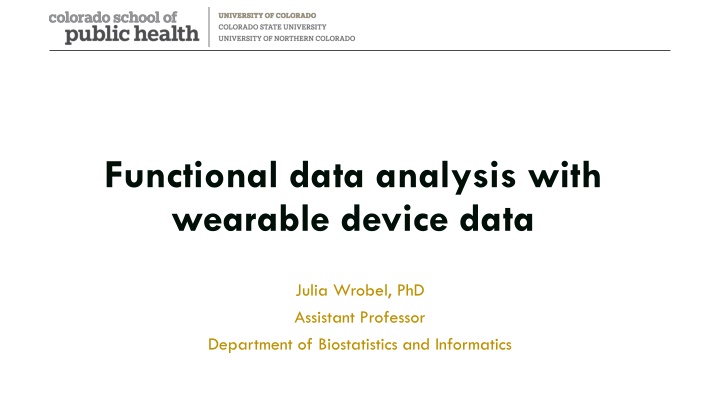
Physical Activity Patterns Using Functional Data Analysis
Explore the vast potential of functional data analysis in analyzing wearable device data, focusing on physical activity patterns. Learn how wearables offer insights into various health markers like sleep, circadian rhythms, and more. Dive into the unique data processing pipeline for accelerometer data and discover the applications of FDA in wearables for advanced data interpretation and comparisons across studies and devices.
Download Presentation

Please find below an Image/Link to download the presentation.
The content on the website is provided AS IS for your information and personal use only. It may not be sold, licensed, or shared on other websites without obtaining consent from the author. If you encounter any issues during the download, it is possible that the publisher has removed the file from their server.
You are allowed to download the files provided on this website for personal or commercial use, subject to the condition that they are used lawfully. All files are the property of their respective owners.
The content on the website is provided AS IS for your information and personal use only. It may not be sold, licensed, or shared on other websites without obtaining consent from the author.
E N D
Presentation Transcript
Functional data analysis with wearable device data Julia Wrobel, PhD Assistant Professor Department of Biostatistics and Informatics
What do wearables offer? Sleep Circadian Rhythmicity Light, Temperature (Circadian markers) Blood Glucose Monitoring Electronic diary/Ecological momentary assessment (1-2-4 per day) Heart Rate (ECG, BPM) Physical activity Activity Counts Sedentary behavior Steps and Gaits
Accelerometer data processing pipeline PA measures: Total steps / counts, MVPA minutes, Sedentary measures: Sedentary time, number of sedentary bouts
Functional data analysis (FDA) Wearable devices record signal over 24-hour periods- the exact focus of FDA! Outcome is curve or function ??? For accelerometer data each curve/outcome is a 24-hour activity profile There are functional analogs of common data analysis tools Functional regression, functional principal components analysis
Uses for FDA in wearables Less pre-processing of the raw data Compare across different studies Compare across devices, manufacturers, wear locations Better ways of imputing data Missing data is a big problem in wearables Time-dependent interpretations, potentially across devices Timing and consistency Integrating all behaviors (jointly analyze PA, sleep, sedentary behavior)
Goals of this analysis Understand patterns of physical activity using functional data methods Huge dataset (>80,000)- still computationally feasible? Focused on age, gender differences in daily patterns of PA Analyzed an average 24-hour day for each subject
UK Biobank Accelerometry Data 88,793 subjects 39,255 men and 49,538 women 42-78 years of age (mean: 61.9 years of age) Raw acceleration data was aggregated reproducibly Euclidean norm minus one (ENMO) of raw tri-axial accelerometer data Produces sub-second activity count that is open-source and reproducible Averaged activity count at minute level for each subject Produces 24-hour minute-by-minute trajectories or activity profiles 1440 minutes of observation for each subject
Diurnal patterns in physical activity across ages Average activity intensity across ages for males (left) and females (right) from functional regression
UK Biobank Analysis Takeaways PA decreases with age for males and females This decrease occurs predominantly in afternoon/evening hours Females have higher probability of being active, especially at older ages Comes from FDA analysis of sedentary behavior in this data Similar patterns are seen in BLSA, NHANES Suggests social/behavioral patterns shared across populations
Other ongoing wearables and FDA projects Using patterns of sedentary behavior to detect human chronotypes Chronotypes are behavioral manifestations of circadian rhythms Clustering daily weigh-in data Bluetooth scales as wearable data Are certain patterns in weigh-ins associated with long-term weight maintenance?
Thanks! Contact Info julia.wrobel@cuanschutz.edu juliawrobel.com github.com/julia-wrobel
Activity drop off occurs mainly in evening hours Average cumulative activity intensity for males (left) and females (right)
Reproducibility and rigor A good deal of this isn t settled Consider MVPA How are counts generated? How are cutpoints found? Are these consistent across devices? Age groups? Placements Some general recommendations Keep rawest form of data possible Process using non-proprietary software Follow a plan to ensure reproducibility
